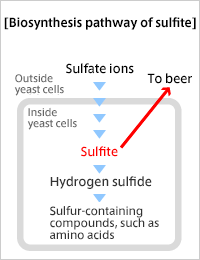- Suntory Global Innovation Center
- > Research & Technology
- > World first! Suntory maps the genome of beer yeast
- > Select the best yeasts to make delicious beer
Research & Technology

Because we have now mapped the entire genome for beer yeast, it is now easy to obtain information on beer yeast genes. This information allows us to analyze the functions of characteristic genes to come up with a group of them that contribute to the fermentation traits. We can also get clues on how to ensure the reliable production of delicious beer by identifying the control mechanisms for these genes. Most importantly, bottom-fermenting yeast produced by the natural hybridization between S. cerevisiae and related species has a set of genes derived from an ancestor that it does not share with top-fermenting yeast. We can assume that it is this distinctive set of genes that give bottom-fermenting yeast its unique characteristics.
1. Oxidation is the enemy of good beer
Oxidation is one of the key factors in deteriorating beer quality. When various substances in beer react with oxygen, the beer loses its freshness and develops unpleasant tastes and flavors. Decreasing the oxygen concentration in the brewing process reduces the risk of oxidation, but it also inhibits yeast activity, making it extremely difficult to drop oxygen concentration while maintaining good fermentation. The challenge is developing ways to prevent oxidation while maintaining robust yeast activity.
2. Sulfite produced by beer yeast are natural flavor stabilizers
Sulfites are used as antioxidants in everything from foods and beverages to pharmaceuticals. Our research revealed that the concentration of sulfites in beer correlates to consistent flavor and taste. Sulfite, which are produced by beer yeast, therefore act as natural stabilizers that ensure the most delicious brews.
3. How do sulfite work, and how can we produce more of them?
Sulfite are produced as an intermediate metabolite in the synthesis of substances containing sulfur, such as methionine and cysteine. It has been reported that sulfite is increased by overexpression of the genes upstream of sulfite synthesis and suppression downstream. However, sulfite themselves actually damage yeast because they are powerful deoxidizers, meaning that excessive synthesis of sulfite interferes with good fermentation. Our challenge was to find a mechanism by which the sulfite produced in yeast cells could be efficiently excreted from them.
In 1994, Xu et al. discovered the SSU1 gene. Subsequent analysis clarified that SSU1 gene products were localized on cell membranes, and they functioned as sulfite pump (Park and Bakalinsky, 2002). This led us to suspect that the SSU1 gene might affect the production of sulfite in beer as well.

- Reference
- Xu X, Wightman JD, Geller BL, Avram D, Bakalinsky AT. Current Genetics. 25, 488-96 (1994)Park H, Bakalinsky AT. Yeast. 16, 881-888 (2002)
4. Powerful sulfite pump unique to beer yeast
The top-fermenting yeast used to produce ales produces relatively few sulfite, while the bottom-fermenting yeast used for lagers can produce 10–20 ppm of sulfite. As indicated earlier, bottom-fermenting yeast has a set of genes derived from an ancestor strain that hybridized with S.cerevisiae. We compared the effects of cerevisiae-derived (Sc-type) SSU1 genes with those of SSU1 genes unique to bottom-fermenting yeast in order to analyze sulfite production.
- Experimental method
- The most effective way to conduct a functional genetic analysis is generally to estimate the functions of target genes by examining changes that occur after disruption or overexpression. We therefore prepared strains in which Sc-type and non-Sc-type SSU1 genes were disrupted or overexpressed, and then conducted beer fermentation tests using these strains.
- Results and discussion
- Disruption in each SSU1 gene revealed that the examined beer yeast had two Sc-type and three non-Sc-type SSU1 genes. We prepared strains in which we reduced the number of a single gene by one, two, or three, and also prepared strains in which each of the SSU1 genes were overexpressed, using strong promoters that trigger constitutive expression.
With these strains, we conducted fermentation tests using wort, and then compared the amount of sulfite production.
![[Results of fermentation tests]](../../img/research/t_genome/detail02_03.gif)
![[Strains used for fermentation tests]](../../img/research/t_genome/detail02_02.gif)
The strain missing the two Sc-type SSU1 genes (strain B) produced almost the same amount of sulfite as the parent strain, but the strains missing two or all non-Sc-type SSU1 genes (strains D and E) produced little sulfite. Because yeast proliferation was slow in strains D and E and fermentation did not progress well in these strains, we reconfirmed that efficient excretion of sulfite out of yeast cells was important for yeast proliferation and good fermentation.
Further, the strain in which Sc-type SSU1 genes were overexpressed (strain F) produced 1.5 times more sulfite than the parent, and the strain in which non-Sc-type SSU1 genes were overexpressed (strain G) produced about 4 times more, suggesting that the non-Sc-type SSU1 genes and their gene products substantially affected sulfite production in beer yeast.
- Reference
- Tomoko Fujimura, Bioscience and Industry, 61(12) 809-810 (2003)
* The department name, title, and photo are as of the time of the production (interview).
* The department name, title, and photo are as of the time of the production (interview).

